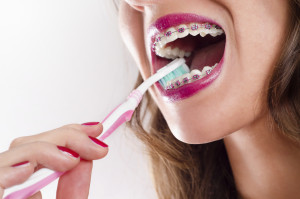 Braces—the right of passage for all early teens whose parents have good insurance. Spend two years in orthodontics purgatory, endure some teasing—like being called ‘metal mouth’, follow the hygiene orders of your orthodontist, and by the time you’re studying high school Geometry, the only rectangles and trapezoids your classmates can talk about are those perfectly positioned pearly whites inside your mouth. Now onto that other self-esteem killer, acne.
Braces—the right of passage for all early teens whose parents have good insurance. Spend two years in orthodontics purgatory, endure some teasing—like being called ‘metal mouth’, follow the hygiene orders of your orthodontist, and by the time you’re studying high school Geometry, the only rectangles and trapezoids your classmates can talk about are those perfectly positioned pearly whites inside your mouth. Now onto that other self-esteem killer, acne.
It never really had to be that way. Braces are effective at any age. That’s because how they work is rather simple. They adjust teeth position by putting a constant pressure on them. Since fully grown bones—in this case, jawbones—are more solid than developing ones, it is faster to straighten teeth in post-teenage adults. However, braces don’t work any better during this time. In fact, since teeth continue to shift as we age, waiting a little longer can sometimes be preferred.
At your regular dental cleanings and exams, you can begin the conversation about teeth straightening. But it will be an orthodontist, not a dentist, who will do the work of aligning teeth, jaws, and bite patterns. When orthodontics begins will depend on each individual patient and which method of straightening they use.
Types of Braces or Teeth Straightening Devices
Traditional braces—These are the visible brackets that look like you’ll be setting off metal detectors at airports and bank vaults. In reality, the metal brackets are stainless steel and won’t set off alarms. So, there’s no reason you can’t flash your friendly TSA agent a big smile on your way to that multi-hour flight delay. In fact, these are commonly made with ceramics these days, which match tooth and gum color a little more closely than aircraft carrier gray. They’re still visible, just absent all that silver and gray.
In any case, you’ll have regular appointments with your orthodontist to adjust the wires. Young teens typically wear these braces for about 2 years. Adults should plan to wear the braces longer than a younger person would. Every patient is different, but an additional year of braces is common for adults.
Clear aligners—These are technically not braces, but their goal is the same: to straighten teeth. These devices are removable trays that fit over your teeth, with each tray adjusting your teeth slightly over time. As their name indicates, they are clear, making them harder to see and a good option for people who may be self-conscious about wearing traditional braces or who are in professions that require a lot of face-to-face meetings and presentations. One can only hear so many remarks about one’s orthodontics before smiling becomes a chore.
Aligners are easy to care for. Warm water and soap or toothpaste is all it really takes to keep hygiene levels high. These aligners can be removed when eating or brushing your teeth or beginning a pop music album. (Backstory: Grammy-winner and pop music sensation Billie Eilish begins her hit song ‘Bad Guy’ with this lyric, “I have taken out my Invisalign, and here is my album.”) Invisalign is a brand name of a popular aligner.
The only ‘bad’ thing about these ‘guys’ is the trays have to be changed out every few weeks. Your orthodontist will provide those trays to you. And the good news is these guys take about the same amount of time to show results as traditional braces.
Some brands of aligners, called at-home aligners, can be ordered directly by you, without seeing an orthodontist. While that sounds convenient and modern-era, it can be an error for anyone with a complicated dental history or dental situation. Not all patients are alike, so any teeth straightening method that doesn’t take all nuances into account can backfire.
Other Solutions for Straightening Teeth
Lingual appliances—If you are uber self-conscious about wearing braces as an adult or older adult, or if you are a performing artist of some kind whose Civil War era character just can’t suspend disbelief wearing the gadget Billie Eilish wears, then consider lingual appliances. Lingual appliances are placed behind the teeth so no one can see them. There’s a catch (sometimes and literally): lingual appliances can press on the tongue and make it hard to speak.
Surgery—When in doubt, operate. No! No one said that, ever. But in some cases, a patient may need surgery as well as braces. Usually, this is related to complications with one’s jawbone. After the surgery, most patients still need to use other types of braces or orthodontics.
After any sort of teeth straightening, your orthodontist will prescribe retainers that you wear—typically overnight—to prevent your teeth from shifting.
Before any sort of teeth straightening, you’ll want to research the cost. Full treatment from an orthodontist may cost thousands of dollars and most dental insurance doesn’t cover those expenses in full.







Leave a Reply